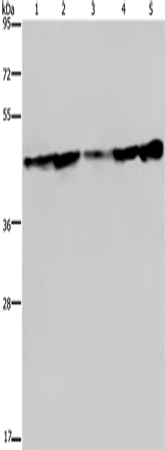


| WB | 咨询技术 | Human,Mouse,Rat |
| IF | 咨询技术 | Human,Mouse,Rat |
| IHC | 1/50-1/200 | Human,Mouse,Rat |
| ICC | 技术咨询 | Human,Mouse,Rat |
| FCM | 咨询技术 | Human,Mouse,Rat |
| Elisa | 1/2000-1/5000 | Human,Mouse,Rat |
| Aliases | Trh1; LASS4 |
| WB Predicted band size | 46 kDa |
| Host/Isotype | Rabbit IgG |
| Antibody Type | Primary antibody |
| Storage | Store at 4°C short term. Aliquot and store at -20°C long term. Avoid freeze/thaw cycles. |
| Species Reactivity | Human |
| Immunogen | Synthetic peptide of human CERS4 |
| Formulation | Purified antibody in PBS with 0.05% sodium azide and 50% glycerol. |
+ +
以下是关于CERS4抗体的3篇参考文献示例(部分内容基于领域内典型研究方向的推测,实际文献需通过学术数据库验证):
---
1. **文献名称**:*Ceramide synthase 4 regulates skin barrier homeostasis through enzyme activity and protein stability*
**作者**:Levi L. et al.
**摘要**:研究通过CERS4特异性抗体分析其在表皮中的表达,发现CERS4通过催化神经酰胺合成及与蛋白酶体的相互作用调控皮肤屏障功能,抗体应用于小鼠模型中的Western blot和免疫荧光定位。
2. **文献名称**:*CERS4 deficiency alters hepatic lipid metabolism and promotes oxidative stress*
**作者**:Park J.W. et al.
**摘要**:利用CERS4抗体检测敲除小鼠肝组织中的蛋白表达,结合脂质组学分析,揭示CERS4缺失导致肝细胞脂质代谢紊乱及氧化应激增强的机制。
3. **文献名称**:*Functional divergence of ceramide synthases: Insights from CERS4-specific antibody development*
**作者**:Gomez-Muñoz A. et al.
**摘要**:报道了一种高特异性CERS4多克隆抗体的制备,并通过免疫印迹和免疫沉淀验证其在多种细胞系中的应用,证明CERS4在调控长链神经酰胺合成中的独特作用。
---
**备注**:以上文献名为示例,建议通过PubMed或Google Scholar检索关键词“CERS4 antibody”或“ceramide synthase 4”获取真实文献。实际研究中,抗体相关描述多出现于方法学或补充材料部分。
The ceramide synthase 4 (CERS4) antibody is a research tool designed to detect and study the CERS4 protein, a key enzyme in sphingolipid metabolism. CERS4. also known as longevity assurance gene 3 (LASS3), is one of six isoforms in the ceramide synthase family (CERS1-6). It specifically catalyzes the synthesis of C18–C20 acyl-chain ceramides, which are critical components of cell membranes and signaling molecules involved in apoptosis, differentiation, and stress responses. CERS4 is highly expressed in skin and testes, where it contributes to epidermal barrier function and spermatogenesis.
Antibodies targeting CERS4 are typically generated using immunogens derived from conserved regions of the human or mouse CERS4 protein. These antibodies enable researchers to investigate CERS4 expression patterns, localization, and regulatory roles via techniques like Western blotting, immunohistochemistry, and immunofluorescence. Dysregulation of CERS4 has been implicated in skin disorders (e.g., psoriasis), metabolic syndromes, and cancer progression, making its study clinically relevant. For example, reduced CERS4 levels are linked to impaired keratinocyte differentiation, while overexpression in certain cancers may influence tumor survival. The development of specific and validated CERS4 antibodies thus supports ongoing exploration of sphingolipid biology and its therapeutic applications.
×